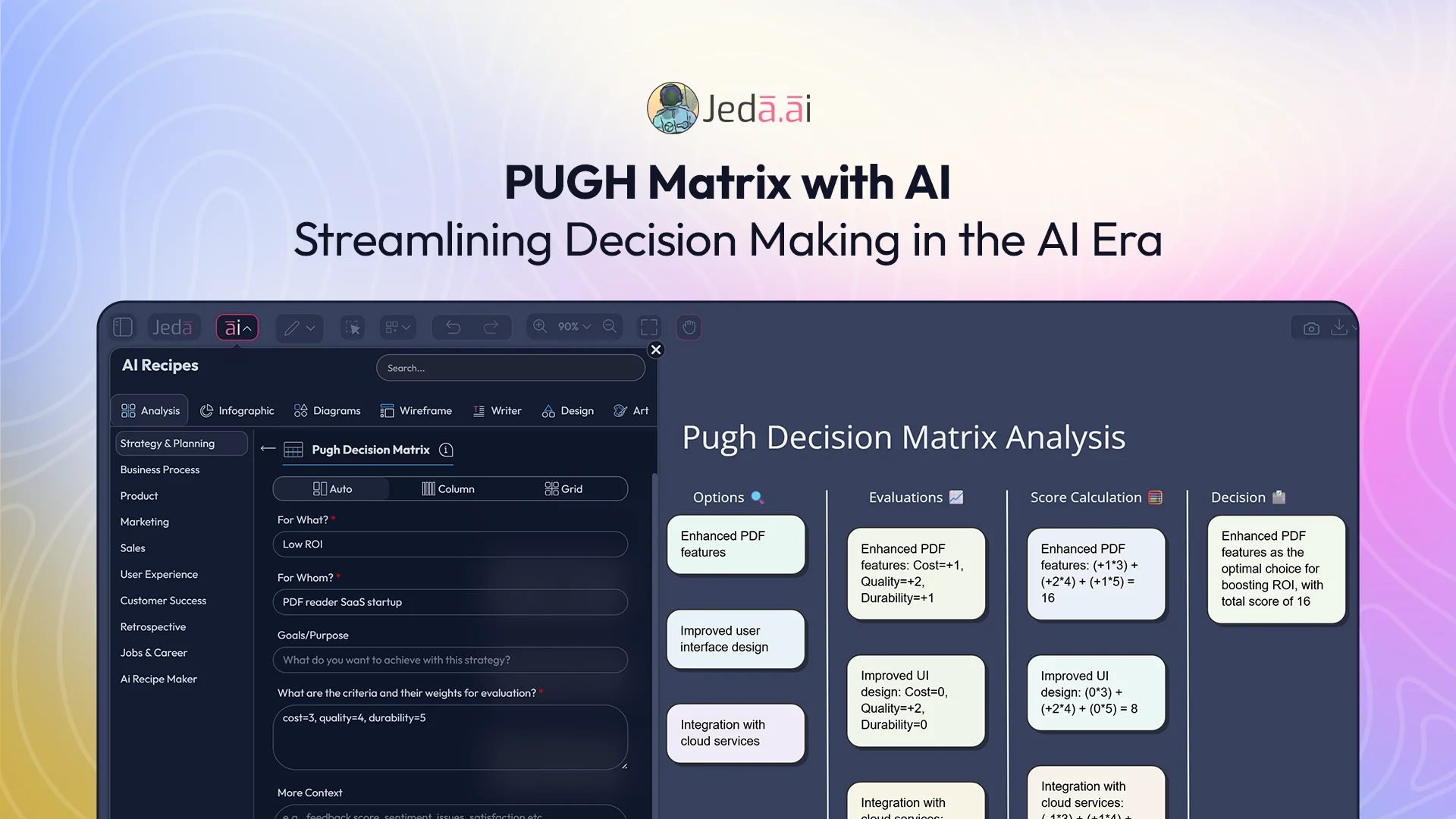
Pugh Matrix with AI: The Ultimate Guide to Smarter Decision-Making
PUGH Matrix with AI can rescue teams from analysis paralysis during complex product decisions. This structured method replaces gut feelings with an objective scoring system for comparing design alternatives. It brings much-needed clarity to concept selection.
Setting up a traditional matrix means manual spreadsheet work, weighing criteria and scoring each concept. It’s a tedious process that often slows down innovation and delays critical go-to-market decisions for product managers seeking the best path forward.
The real power emerges during team workshops, fostering collaborative alignment. By visually scoring options against a baseline, it transforms subjective debates into a transparent, data-informed discussion that everyone can understand and support for project success.
This powerful framework eliminates ambiguity, ensuring your team's energy is spent on innovation, not endless deliberation. It's the smart way to achieve consensus and move forward confidently with a reliable Decision Matrix with AI.

TL;DR: Your Decision-Making, Simplified
🧩 Stop the spreadsheet grind. Automate complex comparisons and scoring.
🧩 Collaborate visually, in real-time. Get everyone on the same page, instantly.
🧩 Make confident, data-backed choices. Leverage AI to validate and strengthen your recommendations.
Transform tedious analysis into streamlined, client-ready strategy with a modern PUGH Decision Matrix with AI.
What is the Pugh Matrix?
Ever feel stuck choosing between several good options for a new product feature? The Pugh Matrix is your escape hatch. It’s a simple but powerful decision grid that helps you compare alternatives objectively, cutting through opinion and bias.
How It Works: A Step-by-Step Overview
First, you establish a baseline for comparison, often your current product or a main competitor. Next, you list your key decision criteria, like development cost, user impact, or technical feasibility. Then, you score each new alternative against the baseline for each criterion using a simple system:
➡️ +1 for better than the baseline.
➡️ 0 for same as the baseline.
➡️ -1 for worse than the baseline.
Why Product Teams Love It
This method transforms endless debates into structured conversations.
For instance, when evaluating three new login authentication methods, the matrix visually reveals if "Option B" scores higher on security but lower on user convenience. This PUGH Matrix with AI-ready structure provides a clear, defensible rationale for your final choice that stakeholders can easily understand.
A Quick Example in Action
Imagine selecting a new homepage layout. Your baseline is the current design. Your criteria include click-through rate and mobile load speed. You'd score new mockups against these, quickly seeing which option offers the best overall improvement, making your Decision Matrix with AI process data-driven and transparent. It’s the ultimate tool for achieving clarity and team alignment on complex product decisions.
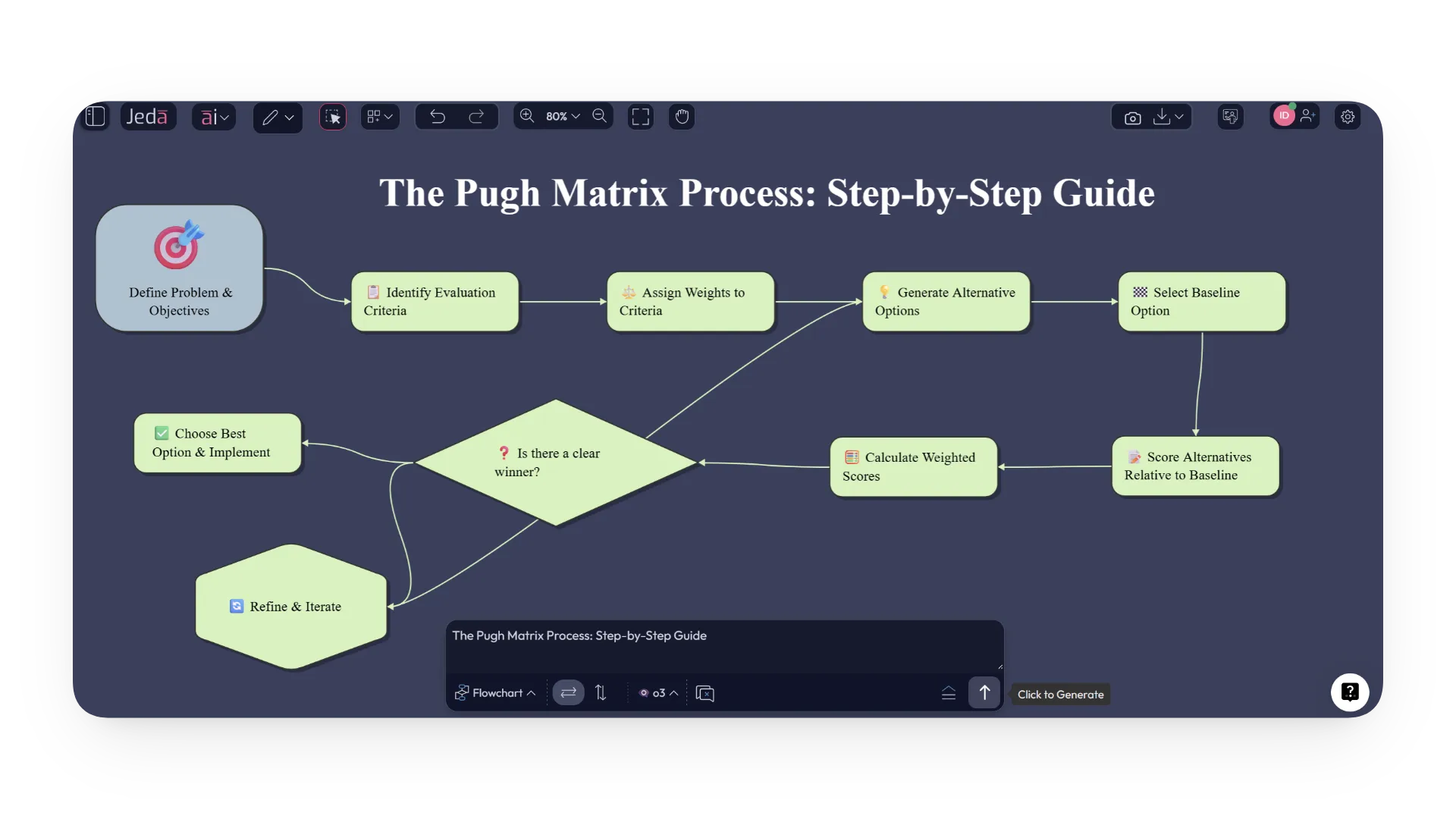
The Pugh Matrix Design Process: Step-by-Step Guide
Stuck in endless debate over which feature to build first? The Pugh Matrix cuts through the noise. It's a straightforward, six-step method to compare options objectively. Let's build one together.
Step 1: Define What Truly Matters
Start by listing your decision criteria. What factors will make or break this choice?
For a new login system, criteria could include development effort, user security, and login speed.
Pro Tip: Avoid vague terms like "good performance." Instead, use measurable metrics like "page load time under 2 seconds." Clarity here prevents arguments later.
Step 2: Establish Your Baseline & List Alternatives
Choose a baseline -your reference point for comparison. This is often your current system or the industry standard. List all potential alternatives you're considering.
➡️ Baseline: Current password-based login.
➡️ Alternative A: Social media login.
➡️ Alternative B: Biometric fingerprint login.
➡️ Alternative C: One-time passwords (OTP).
Step 3: Weight Your Priorities (The Secret Sauce)
Not all criteria are created equal. Assign a weight to each to reflect its importance. A common scale is 1 (low) to 5 (high).
👉 User Security: Weight = 5.
👉 Login Speed: Weight = 4.
👉 Development Effort: Weight = 2.
This tells your team that security is your non-negotiable priority.
Step 4: The Scoring Sprint
Now, score each alternative against the baseline for every criterion. Use this simple scale:
👉 +1 = Better than baseline.
👉 0 = Same as baseline.
👉 -1 = Worse than baseline.
Step 5: Crunch the Numbers
Calculate the weighted total for each option. Multiply each score by its criterion's weight, then sum the results.
🎯 Alternative A (Social): (-1x5) + (1x4) + (1x2) = 1.
🎯 Alternative B (Biometric): (1x5) + (1x4) + (-1x2) = 7.
🎯 Alternative C (OTP): (1x5) + (0x4) + (0x2) = 5.
The highest score points to the strongest contender.
Step 6: Interpret with Insight
Don't just trust the math. Biometric login won, but it scored poorly on development effort. Is that trade-off acceptable? Could you mitigate the development cost? This nuanced analysis, guided by your PUGH Matrix with AI-ready data, is where the real strategic insight happens. It turns subjective opinions into a structured, defensible Decision Matrix with AI outcome that your entire team can support.
When Your Team Needs a Decision-Making Superpower
Feeling overwhelmed by too many options? That's where the Pugh Matrix becomes your secret weapon. This isn't just another framework, it's your escape from analysis paralysis when the stakes are high.

Tame Complex Choices with Multiple Factors
When a simple pros-and-cons list just won't cut it, bring in the heavy artillery. The Pugh Matrix truly shines when you're juggling several alternatives against multiple competing criteria.
Perfect scenarios include, for example:
1. Choosing between three different user onboarding flows.
2. Evaluating four potential technology stacks for a new application.
3. Deciding which market segment to target first with limited resources.
If you find yourself saying "Well, Option A is better for cost, but Option B has better features..." - that's your signal to build a matrix.
Shut Down Opinion Wars with Data
Tired of decisions being swayed by the loudest voice in the room? The Pugh Matrix replaces "I think" with "The data shows." It's particularly valuable when, but not limited to:
1. Different stakeholders have conflicting priorities.
2. Personal preferences are clouding objective evaluation.
3. You need to justify your decision to upper management later.
Imagine your engineering team prefers one approach while design advocates for another. The matrix creates neutral ground where everyone's concerns get weighted fairly.
Get Your Whole Team on the Same Page
The PUGH Decision Matrix transforms messy meetings into productive sessions. When you need buy-in from cross-functional partners, the visual nature of the decisioning matrix makes complex trade-offs crystal clear.
Team scenarios where it excels, for example:
1. Product trios debating feature priorities for the next quarter.
2. Leadership teams evaluating strategic initiatives.
3. Design sprints where you need to converge on one solution
The process itself builds consensus as everyone contributes to setting criteria and scoring alternatives.
Don't Waste Precious Resources
If a wrong choice could cost your team weeks of development time or significant budget, that's exactly when to break out the PUGH Matrix with AI. This decisioning matrix acts as insurance against costly mistakes.
High-stakes situations include, for instance:
1. Selecting a new customer relationship management platform.
2. Choosing which product line to expand versus sunset.
3. Deciding on a major architectural change to your system.
When to Skip the Spreadsheet
This approach might be overkill for straightforward decisions. If you're choosing between two nearly identical options or there's one dominant deciding factor (like budget), a simpler method will suffice.
Save your energy for decisions that truly matter - the ones where multiple factors intersect and the right choice isn't obvious. That's where our Decision Matrix with AI-structured approach delivers maximum value, helping you navigate complexity with confidence and clarity that everyone can support.
PUGH Decision Matrix: Your Secret Weapon for Client Confidence
Tired of defending recommendations with "trust me"? The Pugh Matrix gives you something better: cold, hard evidence. This structured approach transforms how you build consensus and justify strategic choices to skeptical stakeholders.
Turn Subjective Debates into Objective Analysis
Remember that last meeting where everyone argued based on gut feelings? This decisioning matrix eliminates that friction by forcing quantitative scoring. Instead of "I prefer Option A," you get clear data showing Option B scored higher on cost-effectiveness and implementation speed.
Here's how it works in practice, for instance:
1. Client stakeholders each weight criteria according to their priorities.
2. Your team scores alternatives against a neutral baseline.
3. The final calculation reveals the optimal choice mathematically
Pro Tip: This approach is perfect for navigating office politics - the numbers don't play favorites, making your recommendations bulletproof.
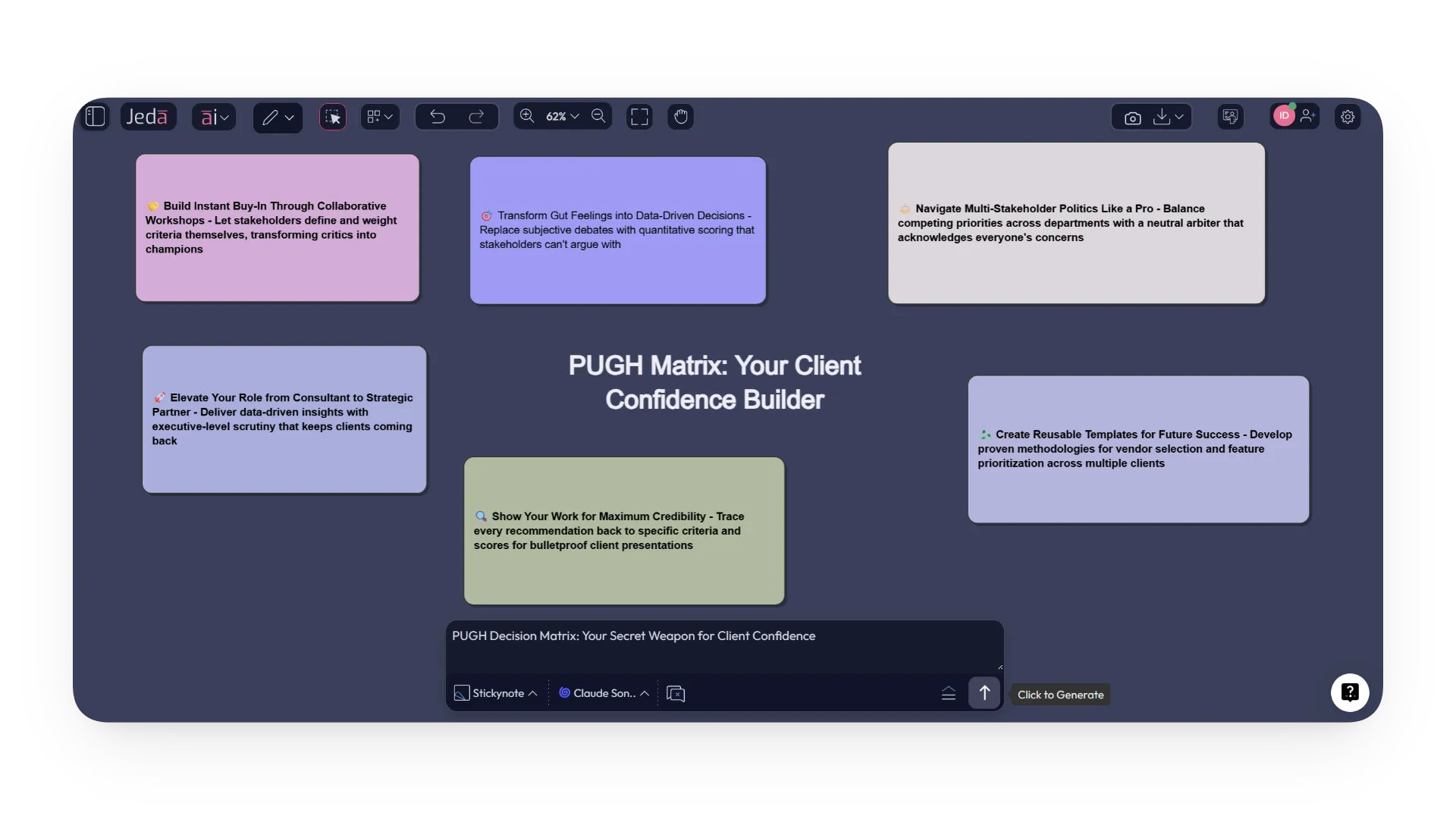
Build Unshakeable Client Trust Through Transparency
Nothing builds credibility faster than showing your work. With a completed decision matrix, you can trace every aspect of your recommendation back to specific criteria and scores. This transparency pays huge dividends during client presentations.
Imagine saying:
"Based on the weighting you provided for budget and scalability, Solution C emerged as the clear winner, outperforming alternatives by 18% on your key metrics."
Master Complex Multi-Stakeholder Environments
Consulting projects often involve balancing competing priorities across departments. The matrix acts as a neutral arbiter when, but not limited to:
1. Marketing wants maximum features.
2. HR demands cost control.
3. IT prioritizes technical stability.
By documenting every trade-off, you create a decisioning framework that acknowledges everyone's concerns while still arriving at the optimal path forward.
Accelerate Team Alignment and Buy-In
The process of building the decision matrix together is often as valuable as the output itself. Facilitated workshops where stakeholders define and weight criteria create instant ownership. Participants see their input directly shaping the outcome, transforming potential critics into champions.
Create Reusable Frameworks for Future Engagements
The hidden benefit? Once you develop a PUGH Matrix template for a specific decision type - like vendor selection or feature prioritization - you can repurpose it across clients. This consistency not only saves time but positions you as bringing proven methodologies to every engagement.
Strengthen Your Strategic Advisory Role
Ultimately, this approach elevates you from being just another consultant to becoming an essential strategic partner. You're not just offering opinions - you're delivering data-driven insights with clear rationale that stands up to executive scrutiny. That's the kind of value that keeps clients coming back.
Don't Let These Pitfalls Derail Your PUGH Decision Matrix Analysis
Even the sharpest consultants can stumble with decisioning frameworks. Knowing these common missteps will keep your Pugh Matrix analysis watertight and defensible.
The Criteria Trap: Vague vs. Overloaded
Your Decision Matrix is only as strong as its foundation.
Watch out for two extremes: overly broad criteria like "user satisfaction" that can't be measured, or including 15+ factors that dilute what truly matters.
Instead, try something like this:
🎯 Transform "ease of use" into "training time under 30 minutes".
🎯 Convert "scalable" into "handles 10,000 concurrent users".
🎯 Limit yourself to 5-7 truly decisive factors.
Ambiguous criteria invite challenging questions during presentations. Specific metrics build confidence.
The Weighting Dilemma: Balancing Act Gone Wrong
Getting weights wrong skews everything.
The most vocal stakeholder shouldn't dictate priorities, nor should every factor be treated equally.
Watch for these red flags, but not limited to:
🫵 Three people assigning different weights to the same criterion.
🫵 Weights that don't reflect actual business impact.
🫵 Ignoring how weighting changes the outcome entirely.
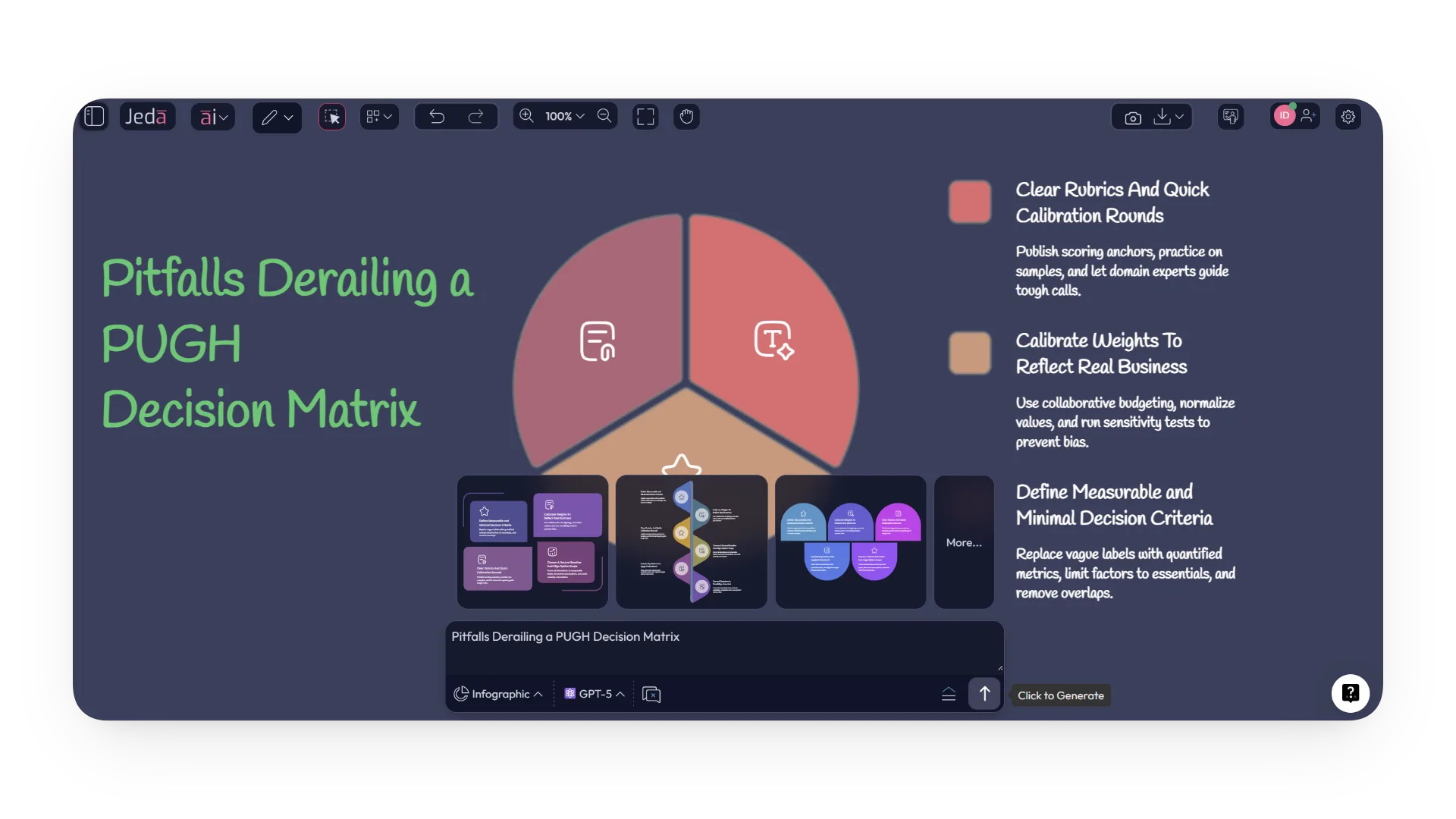
Scoring Inconsistency: The Silent Killer
When team members score differently, your results become meaningless. For instance, if Jane Doe thinks "meets requirements" deserves a +1 but John Doe reserves it for "exceeds requirements," you've got trouble.
Build consistency with:
🫵 Clear scoring definitions everyone references.
🫵 A quick calibration exercise before formal scoring.
🫵 Subject matter experts leading specific criteria evaluation.
The Human Factor: Missing Voices and Over-trusting Numbers
Don't let the PUGH Matrix become a black box. Excluding key stakeholders from the process creates buy-in problems later. Similarly, blindly following the numbers when your gut screams "something's wrong" is a recipe for disaster.
Remember:
The PUGH Decision Matrix informs your recommendation - it doesn't replace your professional judgment. If the top option wins by a hair but has significant implementation risks, you need to flag that.
Beyond the Spreadsheet: Keeping It Real
The most elegant decisioning matrix fails if it doesn't reflect real-world constraints.
Regularly ask: Are we capturing everything that matters? Would this result actually work for the client?
Your PUGH Decisioning Matrix should live and breathe throughout the engagement, not sit frozen in a deck. That adaptability is what separates good consultants from great ones.
PUGH Matrix vs. Other Decision Matrices: What’s the Difference?
Feeling confused by all the different frameworks? You're not alone. Understanding how the PUGH Matrix fits into the decision-making landscape helps you choose the right tool for each client engagement.
The Baseline: What Makes PUGH Unique
While many frameworks exist, the PUGH Matrix stands out with its signature move: baseline comparison. Instead of scoring options in isolation, you measure everything against a reference point - usually the current system or main competitor.
Think of it this way:
♠️ Generic decision matrix: "How good is Option A?"
♠️ Pugh Matrix: "Is Option A better than what we have now?"
This relative approach immediately highlights meaningful improvements over incremental changes.
Beyond Simple Scoring: The Power of Relative Thinking
Other methods might use absolute scales (1-10 scoring), but Pugh's "+1/0/-1" system creates clearer, more defensible comparisons. It answers the client's most fundamental question: "Are we actually getting better?"
Perfect for scenarios like, but not limited to:
♠️ Evaluating whether a new software platform beats the current one.
♠️ Determining if a process redesign delivers real efficiency gains.
♠️ Comparing marketing strategies against the existing approach.
The Consultant's Sweet Spot: Simplicity Meets Rigor
Unlike more complex frameworks that require specialized training, the PUGH Decision Matrix maintains academic rigor while remaining accessible. Team members and clients grasp the logic immediately, which means less time explaining methodology and more time discussing strategic implications.
Workshop Pro Tip:
The visual nature of the PUGH Matrix makes it perfect for collaborative sessions where you need to build consensus in real-time.
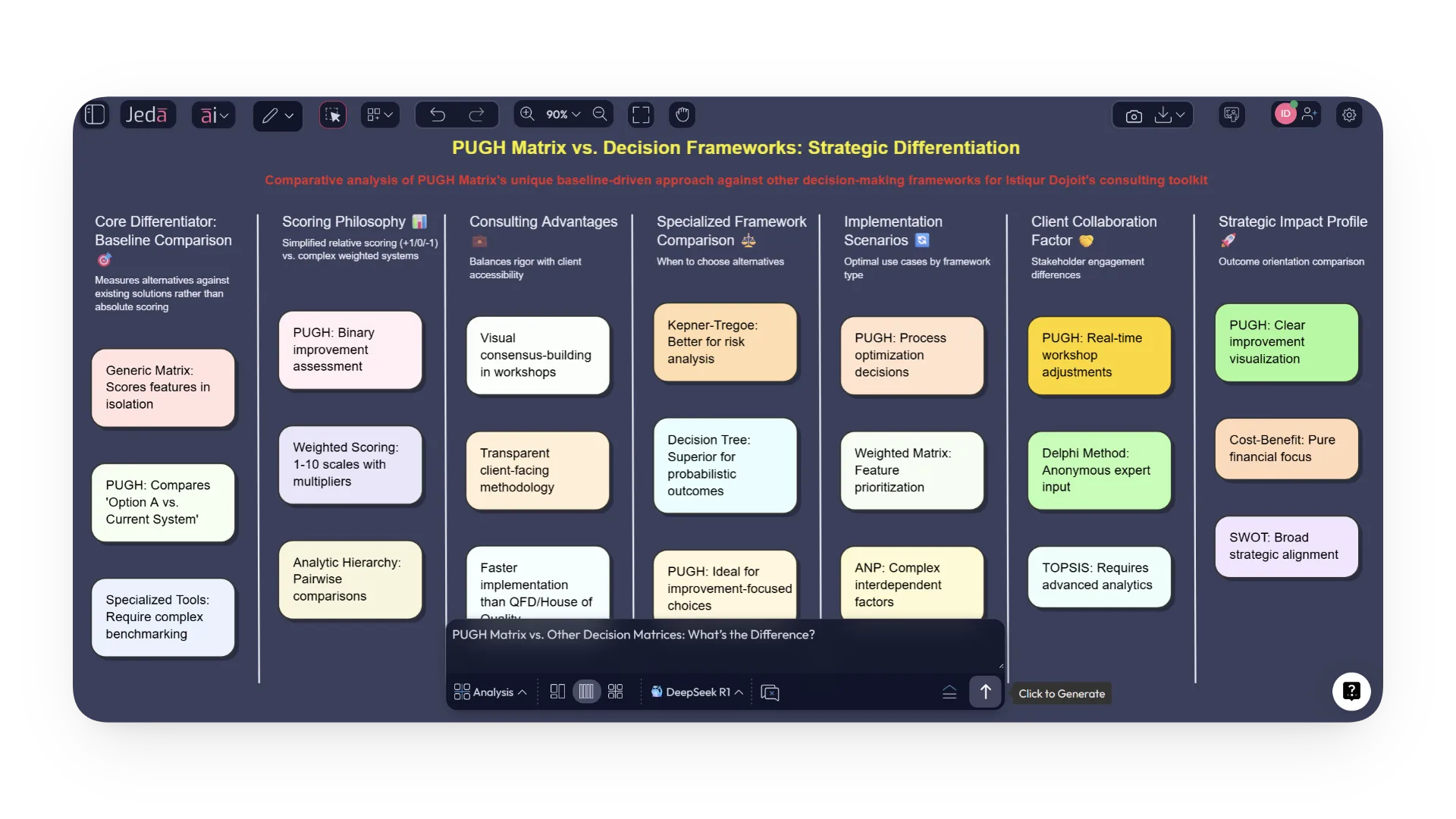
Choosing Your Framework Wisely
While specialized tools exist for specific scenarios, the PUGH Decisioning Matrix hits the sweet spot for most consulting engagements. It's substantial enough to handle complex business decisions yet straightforward enough that clients don't get lost in the methodology.
The true value? You're not just delivering an answer - you're delivering a transparent process that clients can understand, trust, and even reuse internally. That's the kind of value that turns one-time projects into long-term partnerships.
Seeing PUGH Matrix in Action: A Consultant's Scenario
Let's make this practical. Imagine your client needs to choose a new customer support platform. They're currently using a basic system (our baseline) and have three potential replacements to evaluate.
Setting the Stage: Defining What Matters
First, you'd facilitate a session to establish criteria with key stakeholders. Through discussion, you identify, say, four crucial factors:
♦️ Implementation Speed (Weight: 5) - Need to launch within 3 months.
♦️ Integration Capability (Weight: 4) - Must connect to existing CRM.
♦️ Monthly Cost (Weight: 3) - Staying within budget constraints.
♦️ Reporting Features (Weight: 2) - Nice to have, but not critical.
The Scoring Session: Turning Opinions into Data
With criteria set, you evaluate each platform against the baseline:
Platform X (Current baseline): All scores automatically 0 by definition.
Crunching the Numbers: Where the Magic Happens
After applying weights, the totals reveal:
♦️ Platform Alpha: (1×5) + (1×4) + (-1×3) + (0×2) = +6.
♦️ Platform Beta: (-1×5) + (-1×4) + (1×3) + (-1×2) = -8.
♦️ Platform Gamma: (0×5) + (1×4) + (-1×3) + (1×2) = +3.
The Consultant's Interpretation: Beyond the Numbers
Platform Alpha emerges as the clear winner, but your job isn't done. You note that while Platform Gamma, in the above example, scored lower overall, its superior reporting might appeal to specific departments. This nuanced insight allows you to prepare for stakeholder questions and build a more comprehensive recommendation.
The decision matrix hasn't just given you an answer, it's given you a story to tell the client, complete with data to back up every chapter. That's the real power of structured decision-making in consulting.
The Problem with Traditional Decision-Making Approaches (Going It Alone)
✨ The Spreadsheet Struggle is Real: Let's be honest - traditional decision-making often means drowning in spreadsheets. You've probably spent hours formatting tables, debugging formulas, and chasing down data across multiple files. That's valuable time that should be spent on strategic thinking, not administrative busywork.
✨ The Collaboration Conundrum: Remember that last project where one person became the "spreadsheet keeper" while everyone else watched? Traditional methods create bottlenecks where only one person can edit at a time. This leads to version chaos and team members wondering if their input was accurately captured.
Sound familiar?
1. "final_matrix_v3_REALLYFINAL.xlsx"
2. Endless email chains with attached revisions.
3. Team members disengaging because the process feels opaque.
✨ The Update Nightmare: Decisions evolve, but spreadsheets don't make it easy. When new criteria emerge or options change, you're back to manually inserting rows, adjusting formulas, and reformatting.
No wonder many teams abandon their matrices after the first iteration!
✨ Human Error Haunts Every Decision: Even the most careful consultant can transpose numbers or misalign rows. Unlike automated systems, spreadsheets won't flag when a small error completely changes your recommended outcome. That's a risky foundation for important client recommendations.

✨ Analysis Paralysis in Disguise: Ironically, the very tool meant to simplify decisions can become the bottleneck. Teams get stuck in endless tweaking cycles or delay decisions waiting for "the perfect matrix." The process should accelerate decisions, not slow them down.
The good news? There are better ways to handle complex decisions that keep your team engaged and your analysis accurate. The first step is recognizing that spreadsheets might be holding you back more than they're helping.
Other Decision-Making Tools (and Why They’re Not Always Enough)
✨ When Your Go-To Methods Fall Short: We've all been there - that moment when a quick gut check or simple pros-and-cons list just doesn't cut it. While these approaches work for small decisions, they often crumble under the weight of complex client projects where multiple factors intersect.
✨ The Simplicity Trap: Basic methods like team voting or pros-and-cons lists have one major flaw - they can't handle weighted importance. Is a "pro" that saves $10,000 equal to one that saves 10 hours weekly? Without quantification, you're essentially comparing apples to oranges while trying to build a strategic roadmap.
✨ The Complexity Ceiling: On the opposite end, advanced frameworks like analytical hierarchy processes often require specialized training and software. When you're facilitating a client workshop, the last thing you need is to spend half the session explaining methodology rather than driving toward insights.
✨ The Template Tango: Even with pre-made spreadsheet templates, you'll likely spend more time customizing than analyzing. Most templates force your unique decision into their rigid structure, and they completely fail at enabling real-time team collaboration during critical discussions.
Finding the Sweet Spot
What consultants really need is something that balances structure with flexibility - a framework rigorous enough for enterprise decisions yet intuitive enough that clients immediately grasp the logic. The best tools should amplify your expertise rather than complicating your process.
The right approach should feel like having a skilled co-facilitator rather than another tool to manage. It should keep the focus where it belongs - on strategic thinking and client outcomes, not on administrative overhead.
Decision Matrix with AI: A Modern Approach to Smarter Decisions
🎉 Your New Strategic Co-Pilot: Imagine having an extra senior analyst on your team who never sleeps, instantly crunches numbers, and spots patterns everyone else misses. That's the power of bringing AI into your decision-making process. It's not about replacing your expertise, it's about amplifying it.
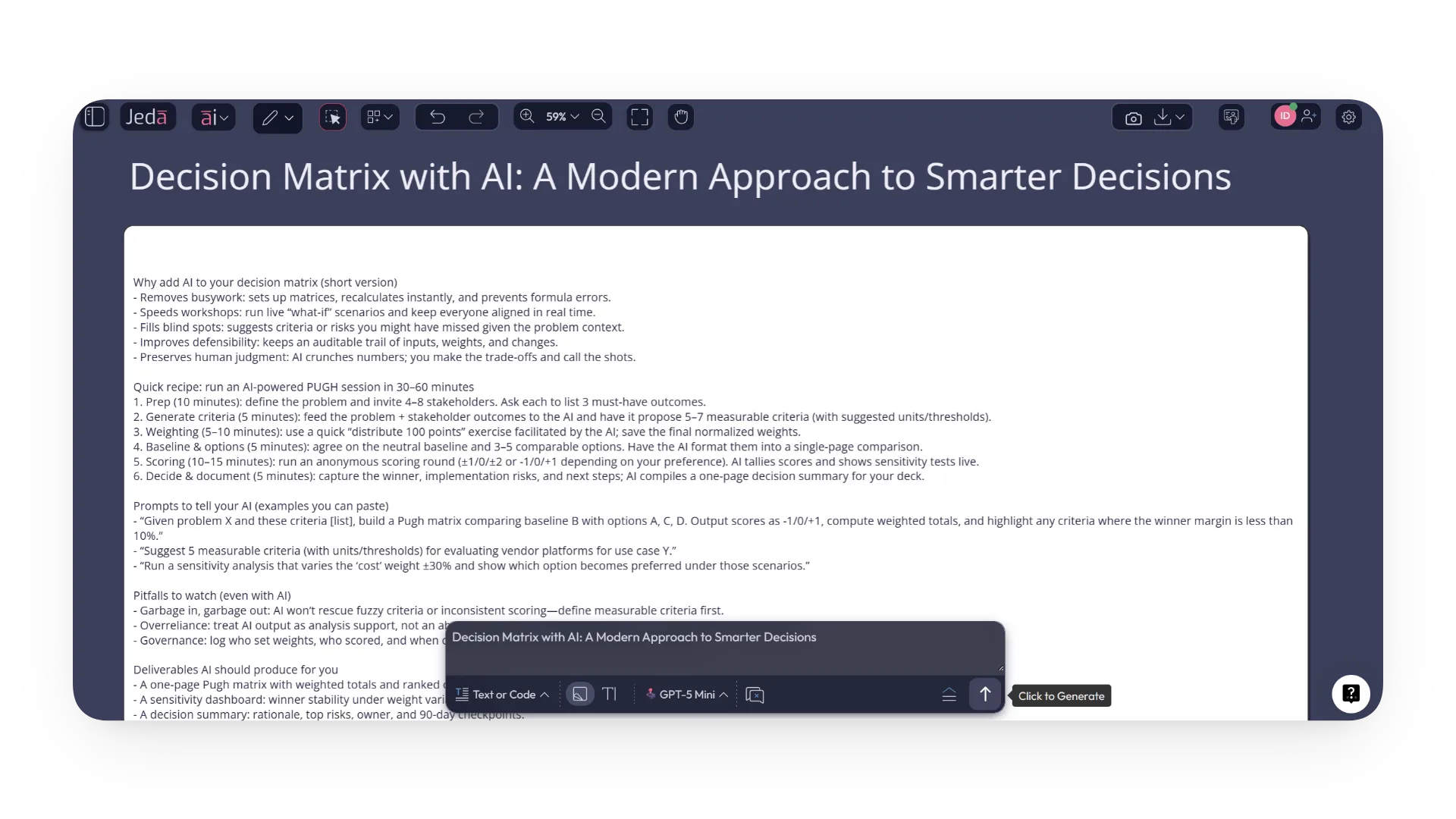
🎉 From Spreadsheet Struggles to Strategic Conversations: Remember those hours spent formatting matrices and debugging formulas? AI handles the administrative grind automatically. The moment you define your criteria and alternatives, it generates a perfect matrix layout. Change a weight? Add a new option? The AI recalculates everything instantly, letting you focus on what matters - the strategic implications.
Think of it as having a brilliant junior partner who:
1. Instantly builds and formats your decision frameworks.
2. Catches calculation errors before they mislead your analysis.
3. Updates everything in real-time during client workshops.
🎉 Your Personal Decision Analyst/Consultant: Ever worry you're missing a crucial criteria? AI can analyze your project context and suggest factors you might overlook. Planning a market entry strategy? It might prompt you to consider "competitive response time" or "local regulatory hurdles" based on similar scenarios.
Workshop Game-Changer: During client sessions, simply ask "What if we prioritized cost over speed?" and watch the decisioning matrix transform in real-time, turning abstract debates into concrete visual comparisons.
🎉 The Bias-Busting Partner You Need: While traditional matrices reduce obvious biases, AI takes it further by providing completely neutral analysis. It has no favorite options or political agendas, just pure data-driven evaluation. When team members champion different solutions, the AI provides an impartial perspective grounded in your agreed-upon criteria.
🎉 From Static Analysis to Dynamic Strategy: The real magic happens when you start exploring scenarios. AI can instantly show how different weighting changes outcomes, highlight options that consistently perform well across criteria, and even flag when a "winner" has critical vulnerabilities. This turns your Decision Matrix from a one-time decision tool into an ongoing strategic exploration platform.
The Human-AI Partnership
Here's the crucial part - you remain the strategic lead.
AI handles the computational heavy lifting while you provide the nuanced judgment, client understanding, and creative problem-solving. It's the perfect partnership; your expertise guides the process, while AI ensures every decision is backed by rigorous, transparent analysis that clients can understand and trust.
This isn't about replacing consultant intuition; it's about enhancing it with data-driven precision that makes your recommendations undeniable.

How Jeda.ai Simplifies Pugh Matrix with AI
🎉 Your Decision-Making Session, Reimagined: Picture this - instead of juggling six different apps, you have one intelligent canvas that thinks along with you. That's the core of simplifying complex analysis with modern technology.
🎉 From Blank Slate to Structured Analysis in Seconds: Remember the drudgery of building matrix templates? Now you can simply describe your decision like "compare three vendor proposals for implementation cost, support quality, and scalability", and watch as a professional framework materializes instantly. Jeda.ai system can even suggest criteria you might have overlooked.
🎉 Collaboration Without the Chaos: Every consultant knows the version control nightmare. With a unified AI workspace, your entire team interacts with the same live PUGH matrix. No more emailing "final_final_v3" spreadsheets. Stakeholders can see the decision evolution, creating unprecedented transparency.
🎉 Error-Proof Calculations: The days of formula errors skewing your recommendations are over. The intelligent assistant handles all computations automatically while you focus on strategic weighting and scoring. You get mathematical precision without spreadsheet struggles.
🎉 Client-Ready From the Start: Because everything lives on a Visual AI Canvas, your analysis naturally evolves into presentation-ready format. No more rebuilding diagrams in slide decks; your working session artifacts become your client deliverables seamlessly.
This approach transforms how consultants facilitate decisions, turning complex analyses into engaging, visual conversations that clients understand and trust immediately.

How to Generate PUGH Matrix with AI on Jeda.ai's Agentic AI Whiteboard
🪄 Log in to Jeda.ai and enter an AI workspace of your choice.
🪄 Navigate to the AI Menu located at the top left corner. Under Strategy & Planning, select the option for PUGH Matrix; or simply use the search box.
🪄Respond to a few intuitive questions related to your business or project.
🪄 Choose your preferred layout and AI model(s).
🪄 You may upload and select your project/product specific data or doc files.
🪄 Hit “Generate”.
AI-Powered Insights and Iteration
🪄 Dynamic Analysis: A PUGH Matrix with Jeda AI transforms static spreadsheets into living analysis. Watch as it instantly recalculates outcomes when you adjust criteria weights, letting you test scenarios in real-time during client meetings.
🪄 Instant Scenario Testing: Simply ask "what if we prioritized cost over speed?" Jeda AI Workspace recomputes everything immediately, revealing how different priorities change your optimal choice. No more manual recalculations or waiting for updated spreadsheets between discussions.
🪄 Visual Trade-Off Analysis: See balanced scorecards showing each option's strengths and weaknesses across all criteria. Immediately spot if your top choice has critical vulnerabilities in key areas, prompting important conversations about risk mitigation strategies.
🪄 Multi-Model Validation: Behind the scenes, multiple AI models cross-check analyses to reduce individual model biases. This creates more reliable recommendations that stand up to rigorous client scrutiny and internal review processes.
🪄 Visual Template Intelligence: Save your Agentic AI Whiteboard as a smart template hub that improves with each use. The system makes your team's decision-making process increasingly sophisticated over time with a robust Decision Matrix with AI.
Best Practices for Using a Pugh Matrix (and Getting the Most from AI)
🧩 Start With Smart Setup: A PUGH Matrix with AI begins with your expertise. Use AI to suggest potential criteria, but apply your client knowledge to finalize the most relevant factors for their unique situation.
🧩 Collaborative Scoring Sessions: Gather your team to review AI-generated scores together. Discuss any discrepancies; these conversations often reveal hidden assumptions and strengthen your collective understanding of the decision landscape.
🧩 Embrace Rapid Iteration: Leverage AI to test multiple weighting scenarios instantly. This encourages exploring different perspectives without the time penalty of manual recalculation, leading to more robust recommendations.
🧩 Tell The Full Story: Use AI-generated visuals to complement your data, creating client-ready materials that clearly explain the rationale behind your recommended choice with a transparent Decision Matrix with AI.
.webp)
Industry Applications and Use Cases for Pugh Matrix with AI
Strategic Decision Acceleration
A PUGH Matrix with AI transforms how consultants approach complex client decisions. Imagine running live strategy sessions where you compare market entry approaches against weighted criteria, with AI instantly calculating optimal pathways as assumptions change.
Operational Excellence Applications
Beyond high-level strategy, this approach excels at operational choices. Evaluate vendor proposals, technology platforms, or process redesigns using dynamic scoring that updates in real-time during client workshops.
Cross-Industry Flexibility
From manufacturing design trade-offs to marketing channel selection, the framework adapts to any multi-criteria decision. AI enhances traditional analysis by suggesting relevant factors and ensuring consistent scoring across complex evaluations.
Client Collaboration Reinvented
The visual, interactive nature of a modern Decision Matrix with AI turns abstract discussions into engaging workshops. Clients see their input directly shaping outcomes, building trust through transparent, data-backed recommendations.
Wrapping Up
Imagine implementing a Decision Matrix with AI that turns grueling analysis into engaging client conversations. This approach eliminates spreadsheet chaos and team disagreements by creating a visual, interactive space where criteria and outcomes evolve in real-time. Consultants report cutting decision cycles by half while delivering more defensible recommendations that clients readily accept. The technology handles the computational heavy lifting while you focus on strategic nuance and stakeholder alignment, fundamentally changing how teams reach consensus on complex business challenges.
This isn't about replacing expertise, it's about amplifying it. The future belongs to consultants who blend human insight with AI-powered analysis, creating recommendations that are both data-rich and contextually intelligent. You'll spend less time building frameworks and more time refining strategy, with clear audit trails that show exactly how each decision was reached. This represents the evolution of consulting excellence, where technology enhances rather than replacing the human elements of judgment and client relationships through a sophisticated PUGH Matrix with AI.




%202.svg)